مجازی سازی عملکرد شبکه در نسل پنجم شبکه های سیار (5G)
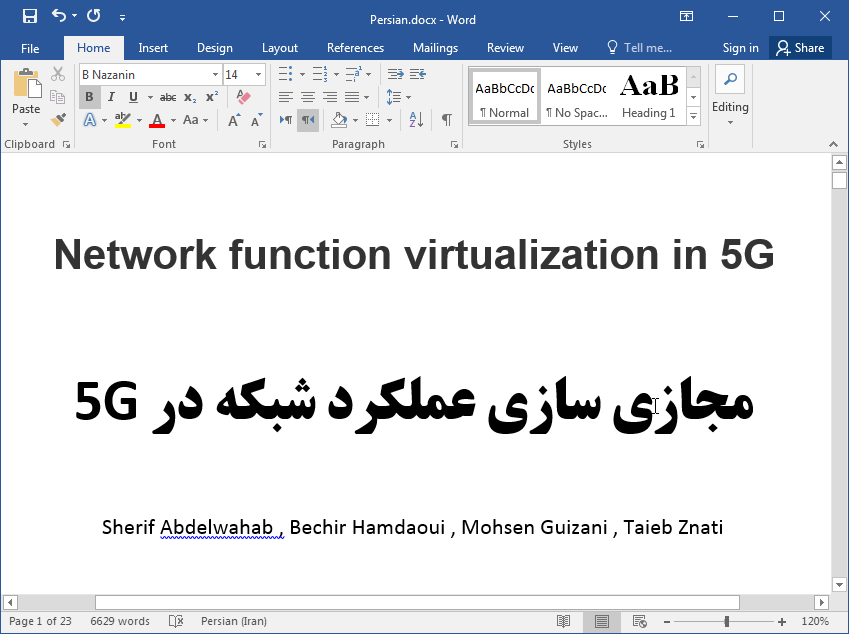
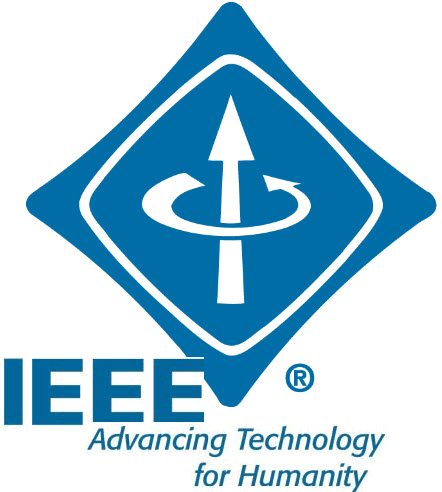
17,500 تومانشناسه فایل: 8031
- حجم فایل ورد: 230.8KB حجم پیدیاف: 373.5KB
- فرمت: فایل Word قابل ویرایش و پرینت (DOCx)
- تعداد صفحات فارسی: 23 انگلیسی: 8
- دانشگاه:
- School of Electrical Engineering and Computer Science (EECS), Oregon State University, Corvallis
- Electrical and Communications Engineering Department at the University of Idaho
- University of Pittsburgh, Pennsylvania
- ژورنال: Communications Magazine (1)
چکیده
فناوری بی سیم نسل پنجم شبکه های سیار سلولی (5G) راه متحول ساختن شبکه سازی فراگیر و بسیار گسترده آینده، برنامه های کاربردی بی سیم و کیفیت تجربه کاربر است. 5G برای محقق ساختن پتانسیل خود باید ظرفیت شبکه را به میزان قابل توجهی افزایش دهد، اتصالات عظیم دستگاه ها با هزینه و تاخیر کم را فعال سازد و در مقایسه با فناوری های بی سیم موجود، ذخیره سازی قابل توجه انرژی به دست آورد. هدف اصلی این مقاله کشف پتانسیل NFV در تشدید زیست پذیری کاربردی، معماری و تجاری شبکه های دسترسی رادیویی 5G است که شامل افزایش خودکاری، مهارت عملیاتی و کاهش هزینه های سرمایه است. گروه مشخصات صنعتی ETSI NFV اخیرا پیش نویس هایی متمرکز بر استانداردسازی و اجرای NFV را منتشر کرده است. با مهار پتانسیل 5G و مجازی سازی عملکردهای شبکه، به بحث در این مورد می پردازیم که NFV چگونه می تواند به چالش های حیاتی طراحی 5G از طریق انتزاع خدمات، منابع شبکه، ذخیره سازی و پردازش مجازی بپردازد. ما در پیاده سازی و اجرای NFV با پوشش شبکه و فناوری های SDN را توصیف می کنیم. در این بحث ما، اولین گام ها را در درک نقش NFV در اجرای CoMP، ارتباط D2D، و شبکه های فوق العاده متراکم پوشش می دهیم.
مقدمه مقاله
در دهه گذشته، تکنولوژی بی سیم به عنوان یکی از مهمترین گرایش های شبکه شناخته شده است. آمارهای اخیر نشان می دهند که نفوذ پهنای باند بی سیم تلفن همراه از شبکه های پهنای باند سیمی ثابت گذشته است. علاوه بر دسترسی کلی به پهنای باند، پیشرفت های اخیر در ارتباطات بی سیم و قابلیت پردازش گره این امکان ارتباط شبکه ها را برای طیف وسیعی از برنامه های کاربردی چند رسانه ای جدید و خدمات بی سیم مناسب پشتیبانی کنند که به سرعت و با قدرت در حال تبدیل به اولویت های ملی هستند. انتظار می رود که این گرایش در آینده با نرخ رشد خیلی سریع تری ادامه پیدا کند. تا سال 2018 ترافیک جهانی تلفن همراه از 2.6 به 15.8 اگزابایت افزایش خواهد یافت. با توجه به رشد نمایی مورد انتظار رسانه های غنی نیاز به تکامل شبکه های سلولی مورد تاکید قرار می گیرد. برای این منظور، نسل 5 از 1000 برابر نرخ داده های مجتمع امروزی و 100 برابر نرخ داده های کاربر پشتیبانی خواهد کرد، در حالی که افزایش 100 برابری تعداد دستگاه های متصل امروزی، کاهش 5 برابری تاخیر پشت سر هم و افزایش 10 برابری طول عمر باتری را فعال می سازد.
برای مواجهه با رشد ظرفیت سه-مرتبه-بزرگی و اتصالات عظیم دستگاه ها، نسل پنجم شبکه های سیار سلولی (5G) اهداف طراحی خود را حول بهره وری، مقیاس پذیری، و تطبیق پذیری قرار می دهد. شبکه های نسل 5 برای حفظ زیست پذیری تجاری خود باید از نظر انرژی، مدیریت منابع، و هزینه در هر بیت بطور قابل توجهی کارآمد باشند. متصل کردن تعداد عظیمی از پایانه ها و دستگاه های عمل کننده با باتری نیازمند پیشرفت عملکردهای مقیاس پذیر و تطبیق پذیر شبکه است که از عهده ی حیطه ی گسترده ای از الزامات خدمات برآید، شامل: انرژی کم، ارتباط نوع-ماشین با نرخ پایین داده ها، نرخ داده های بالای چند رسانه ای، و برنامه های کاربردی حساس به تاخیر، در بین خدمات بسیار دیگر. اهداف بهره وری، مقیاس پذیری، و تطبیق پذیری 5G جامعه 5G را به سوی کشف اجرای ساده اما بدیع عملکردهای شبکه 5G هدایت می کند.
به رغم برتر بودن عملکرد آنها، کارکرد شبکه 5G با چالش های حیاتی و معماری مواجه است. برای مثال چند نقطه ای هماهنگ (CoMP) می تواند تجربه لبه سلول کاربر را با استفاده از ارسال هماهنگ و ترکیبی سیگنال ها از آنتن ها، سلول ها، پایانه ها، و مکان های متعدد به منظور بهبود عملکرد اتصال پایین (DL) و اتصال بالا (UL) (به عنوان مثال توسط زمانبندی هماهنگ، تشکیل پرتو هماهنگ و هم ترازی تداخل) ارتقا دهد. با این حال، CoMP با افزایش محاسبات، افزایش سربار سیگنال رسانی و افزایش بک هال کردن و هزینه امکانات به این دستاورد دست می یابد. علاوه بر این، تعداد عظیمی از دستگاه ها نیازمند شبکه های فوق العاده متراکم، سخت افزار تخصصی، و طراحی دستگاه محور هستند که هنوز به خوبی تعریف نشده اند. در نهایت، نسل 5 باید با فناوری های پیشین مثل نسل 2، نسل 3 و نسل 4 همزیستی کند. این نیاز به تنهایی هزینه و پیچیدگی را بطور نامحدود افزایش می دهد. به این چالش می توان بطور موثری با اجرای عملکردهای شبکه 5G به عنوان اجزای نرم افزاری با استفاده از الگوی مجازی سازی عملکردهای شبکه (NFV) پرداخت.
یک گروه در حال رشد از شرکت ها و مراجع استاندارد سازی درحال پژوهش و گسترش الگوی NFV به منظور ارتقای بهره وری هزینه، انعطاف پذیری، و بطور کلی تضمین عملکرد شبکه های سلولی هستند. در NFV فروشندگان عملکردهای شبکه را در اجزای نرم افزاری بنام عملکردهای مجازی شبکه (VNFs) اجرا می کنند. VNF ها روی زیرساخت ابری یا سرورهای پر حجم بجای سخت افزار تخصصی بکار گرفته می شوند. برای مثال NFV، بجای استفاده از واحدهای مختص پردازش پهنای باند (BBUs) در هر سایت، منابع پردازش سیگنال را در زیرساخت ابر ذخیره سازی می کند. چنین ذخیره سازی منابعی سرباز سیگنال رسانی و محاسباتی را کاهش می دهد، هزینه را بهینه می سازد، و انعطاف پذیری را بهبود می بخشد تا یک تامین کننده خدمات منبع خاص پردازش سیگنال را تنها برای پایانه های خاص در کل شبکه فعال سازد، بجای فعال سازی غیر ضروری تمام منابع در هر سایت.
بطور کلی NFV می تواند بر برخی چالش های 5G فائق آید، توسط:
- بهینه سازی تامین منابع VNF ها برای بهره وری انرژی و هزینه
- حرکت دادن و مقیاس کردن VNF ها از یک منبع سخت افزاری به منبع دیگر
- اطمینان از تضمین عملکرد عملیات های VNF ها، شامل حداکثر نرخ شکست، حداکثر تاخیر، و از دست رفتن قابل تحمل بسته برنامه ریزی نشده
- اطمینان از همزیستی VNF ها با عملکردهای غیر مجاز شبکه
برخلاف سایر کارها روی کاربرد NFV و فناوری های شبکه سازی تعریف شده نرم افزاری (SDN) در شبکه سازی عمومی نسل 5، هسته بسته پیشرفته تکامل بلند مدت (LTE) مجازی، و سایت های (SDR)-محور رادیویی تعریف شده نرم افزاری [3-6]، این کار متمرکز بر اجرای یک چارچوب NFV است که نیازهای فناوری شبکه دسترسی رادیویی (RAN) نسل 5 را برطرف می سازد و عملکردهای پیچیده متعدد نسل 5 را فعال می سازد در حالی که همزیستی آن را با سایر فناوری ها راحت می کند. همچین تاثیر NFV در کاهش هزینه های سرمایه (CAPEX) و هزینه های عملیاتی (OPEX) RAN نسل 5 را نشان می دهد.
در این مقاله، ابتدا به بررسی انتزاع خدمات، طراحی NFV، و مجازی سازی شبکه از طریق مدل پوشش شبکه می پردازیم. همانطورکه NFV فناوری ها را فعال می کند، ما به توصیف چگونگی استفاده از SDN و OpenFlow (جریان باز) برای مجازی سازی و بهم وصل کردن VNF ها می پردازیم. دوم، ما بر عملکردهای رادیویی قابل مجازی سازی 5G تمرکز کرده و CoMP، دستگاه به دستگاه (D2D) بین-سلولی و اجرای شبکه فوق العاده متراکم با استفاده از NFV را توصیف می کنیم. در نهایت در مورد مسائل باز پژوهشی مختص NFV در RAN نسل 5 بحث می کنیم.
ABSTRACT Network function virtualization in 5G
5G wireless technology is paving the way to revolutionize future ubiquitous and pervasive networking, wireless applications, and user quality of experience. To realize its potential, 5G must provide considerably higher network capacity, enable massive device connectivity with reduced latency and cost, and achieve considerable energy savings compared to existing wireless technologies. The main objective of this article is to explore the potential of NFV in enhancing 5G radio access networks’ functional, architectural, and commercial viability, including increased automation, operational agility, and reduced capital expenditure. The ETSI NFV Industry Specification Group has recently published drafts focused on standardization and implementation of NFV. Harnessing the potential of 5G and network functions virtualization, we discuss how NFV can address critical 5G design challenges through service abstraction and virtualized computing, storage, and network resources. We describe NFV implementation with network overlay and SDN technologies. In our discussion, we cover the first steps in understanding the role of NFV in implementing CoMP, D2D communication, and ultra densified networks.
Introduction
In the last decade, wireless technology has emerged as one of the most signifcant trends in networking. Recent statistics show that mobile wireless broadband penetration has exceeded that of fixed wireline broadband networks. In addition to general broadband access, recent advances in wireless communications and node processing capabilities have made it possible for communication networks to provide support for a wide variety of new multimedia applications and compelling wireless services, which are rapidly and steadily becoming national priorities. This trend is expected to continue in the future at much faster growth rates. By 2018, the global mobile traffic will increase from 2.6 to 15.8 exabytes. Addressing the expected exponential growth of rich media underscores the need to evolve cellular networks. To this end, the fifth generation (5G) will support 1000 times the current aggregate data rate and 100 times the user data rate, while enabling a 100 times increase in the number of currently connected devices, 5 times decrease of end-to-end latency, and 10 times increase of battery lifetime [1].
To meet the expected three-orders-of-magnitude capacity improvement and massive device connectivity, 5G centers its design objectives around efficiency, scalability, and versatility. To sustain its commercial viability, 5G networks must be significantly efficient in terms of energy, resource management, and cost per bit. Connecting a massive number of terminals and battery operated devices necessitates the development of scalable and versatile network functions that cope with a wider range of service requirements including: low power, low-data-rate machine-type communication, high data rate multimedia, and delay-sensitive applications, among many other services. The efficiency, scalability, and versatility objectives of 5G direct the 5G community toward finding innovative but simple implementations of 5G network functions.
5G network functions face critical functional and architectural challenges in spite of their performance superiority. Coordinated multipoint (CoMP), for instance, can improve the cell edge user experience by using coordinated and combined transmission of signals from multiple antennas, cells, terminals, and sites to improve the downlink (DL) and uplink (UL) performance (e.g., by coordinated scheduling, coordinated beamforming, and interference alignment). However, CoMP achieves this gain with increased computation, increased signaling overhead, and increased backhauling and equipment cost. Moreover, the massive number of devices requires ultra densified networks, specialized hardware, and device-centric architecture that are not well defined yet. Finally, 5G must coexist with legacy technologies like 2G, 3G, and 4G. This requirement alone increases cost and complexity indefinitely. These challenges can be effectively addressed by implementing the 5G network functions as software components using the network functions virtualization (NFV) paradigm.
A growing group of companies and standardization bodies are pushing research and development of the NFV paradigm to improve cost efficiency, flexibility, and performance guarantees of cellular networks in general.1 In NFV, vendors implement network functions in software components called virtual network functions (VNFs). VNFs are deployed on high-volume servers or cloud infrastructure instead of specialized hardware. For example, NFV pools the signal processing resources in cloud infrastructure rather than using dedicated baseband processing units (BBUs) at every site. Such resource pooling reduces computational and signaling overhead, optimizes cost, and improves fl flexibility so that a service provider activates a particular signal processing resource for only specific terminals in the whole network instead of activating all processing resources unnecessarily at each site. Generally, NFV can overcome some challenges of 5G by:
- Optimizing resource provisioning of the VNFs for cost and energy efficiency
- Mobilizing and scaling VNFs from one hardware resource to the other
- Ensuring performance guarantees of VNFs operations, including maximum failure rate, maximum latency, and tolerable unplanned packet loss
- Ensuring coexistence of VNFs with non-virtualized network functions [2]
Unlike other work on application of NFV and software defined networking (SDN) technologies in generic 5G networking, virtualized Long Term Evolution (LTE) evolved packet core, and software defined radio (SDR)-based sites [3–6], this work focuses on the implementation of an NFV framework that meets 5G radio access network (RAN) technology requirements and enables several complex 5G functions while smoothing its coexistence with other technologies. We also demonstrate the effectiveness of NFV in reducing the capital expenditures (CAPEX) and operational expenditures (OPEX) of the 5G RAN.
In this article, we f rst survey service abstraction, architecture of NFV, and network virtualization via the network overlay model. As NFV enabling technologies, we describe how to use SDN and OpenFlow to virtualize and interconnect VNFs. Second, we focus on 5G virtualizable radio functions and describe CoMP, inter-cell device-to-device (D2D), and ultra densified network implementation using NFV. Finally, we discuss open research problems specific to NFV in 5G RAN.
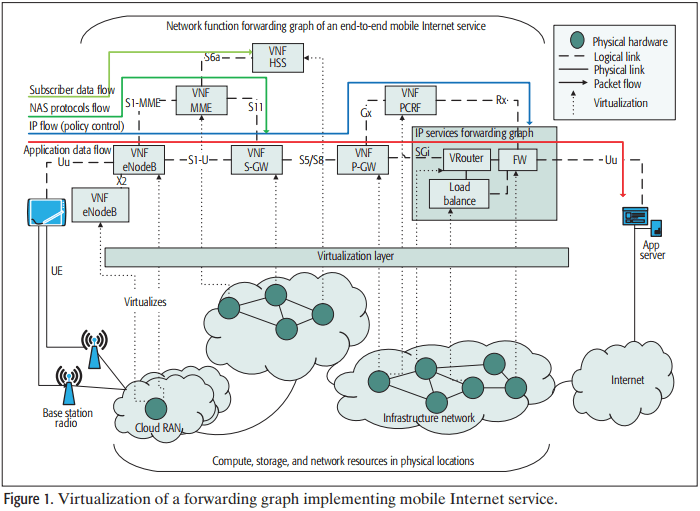
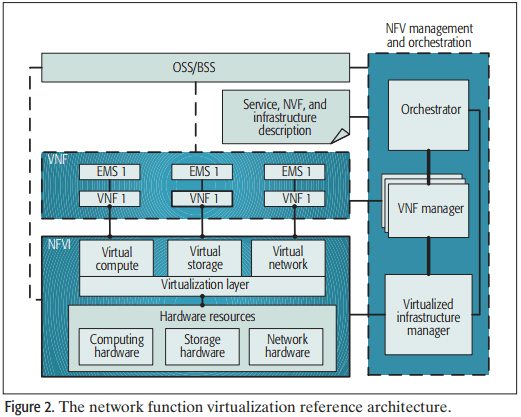
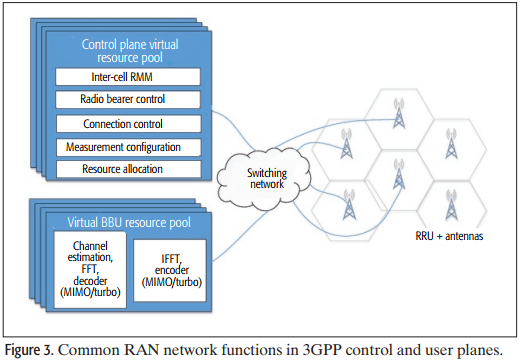
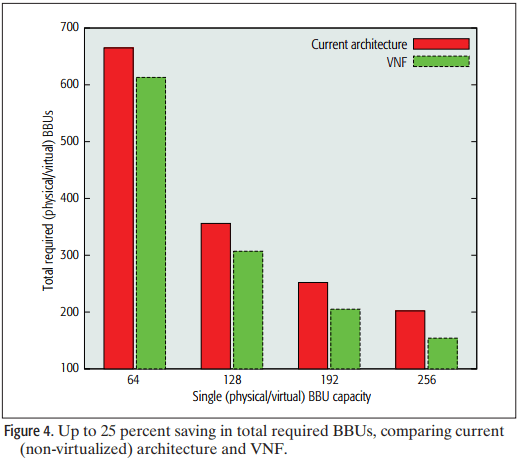

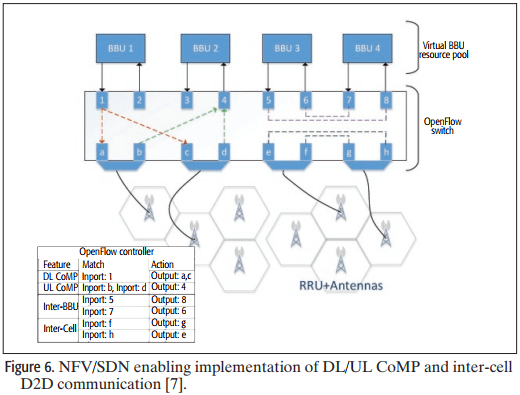
- مقاله درمورد مجازی سازی عملکرد شبکه در نسل پنجم شبکه های سیار (5G)
- مجازی سازی عملکرد شبکه در 5G
- پروژه دانشجویی مجازی سازی عملکرد شبکه در نسل پنجم شبکه های سیار (5G)
- مجازی سازی تابع قابلیت های شبکه در G5
- پایان نامه در مورد مجازی سازی عملکرد شبکه در نسل پنجم شبکه های سیار (5G)
- تحقیق درباره مجازی سازی عملکرد شبکه در نسل پنجم شبکه های سیار (5G)
- مقاله دانشجویی مجازی سازی عملکرد شبکه در نسل پنجم شبکه های سیار (5G)
- مجازی سازی عملکرد شبکه در نسل پنجم شبکه های سیار (5G) در قالب پاياننامه
- پروپوزال در مورد مجازی سازی عملکرد شبکه در نسل پنجم شبکه های سیار (5G)
- گزارش سمینار در مورد مجازی سازی عملکرد شبکه در نسل پنجم شبکه های سیار (5G)
- گزارش کارورزی درباره مجازی سازی عملکرد شبکه در نسل پنجم شبکه های سیار (5G)
